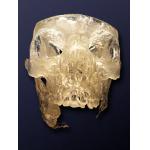RP Industry to Help Iraqi War Victims
Complex craniofacial reconstruction and orthopedic limb reduction surgery is first focus of humanitarian effort
May 1, 2005
By DE Editors
On May 10 at the Society of Manufacturing Engineers (SME) Rapid Prototyping & Manufacturing conference in Dearborn, Michigan, leaders of the Rapid Prototyping (RP) industry announced free medical support for victims of the war in Iraq. “RP for Baghdad” is a joint humanitarian effort led by Fried Vancraen of Materialise, Abe Reichental of 3D Systems, Scott Crump of Stratasys, and Tom Clay of Z Corporation to provide medical models for victims in Iraq.
The effort will focus on the most severely injured victims with serious head injuries or missing limbs. While helping people in serious need, the RP industry will demonstrate how its technology can fundamentally influence people’s lives for the better. Even in the difficult environment of war, 3D printed models based on medical image data are important tools to support surgeons in the most complex craniofacial reconstruction surgeries.
|
|
| Medical model of skull with gunshot trauma. Courtesy of RP4Baghdad. |
The Iraqi League for Medical Profession is providing the infrastructure for this service. People with serious injuries will first be CT Scanned at a medical facility. The data from the scan will be processed using the Mimics software of Materialise to generate a 3D Model of the anatomy. 3D Systems, Stratasys, and Z Corporation will provide physical models based from the virtual model. The models will be delivered back to a surgeon in Iraq who can use this bone replica to plan and practice surgery on. As the project progresses the plan is to build RP parts for socket construction in artificial limbs.
The use of rapid prototyping in the medical field starts with digital CT scan data, from which it’s possible to print exact replicas from parts of the human body. For example, if you scan a person’s head and make a model of their skull. These medical models offer surgeons the possibility to study, prepare, and even practice before starting complex surgeries. A well-known example of the use of medical models was the separation of the Egyptian conjoined twins Ahmed and Mohamed in October 2003. Without the models provided by Medical Modeling Corporation, this surgery would have never been attempted.
The RP for Baghdad website online just recently. The organization is looking for medical model builders, additional sponsors, and cash donations.
Please visit the site at by clicking here. Then click on the “Can I Help” tab to support this effort.
Subscribe to our FREE magazine, FREE email newsletters or both!
About the Author
DE’s editors contribute news and new product announcements to Digital Engineering.
Press releases may be sent to them via [email protected].







